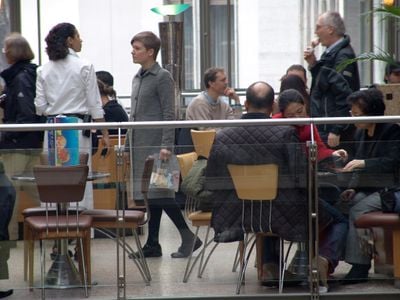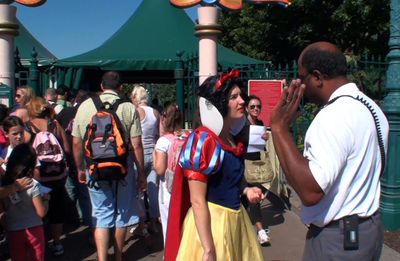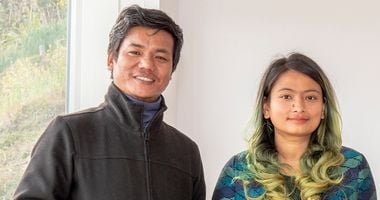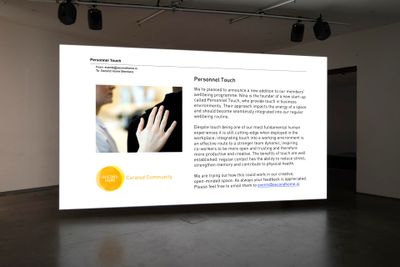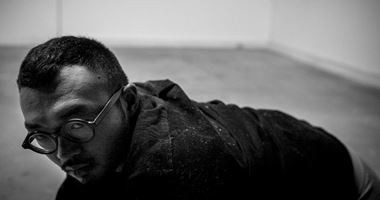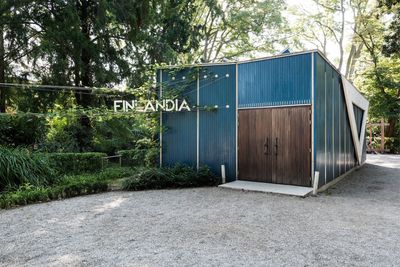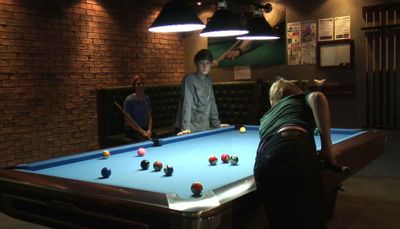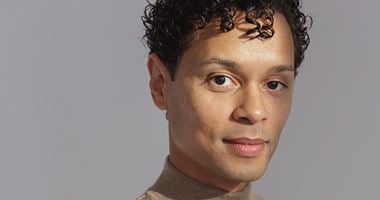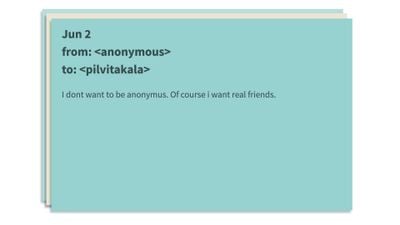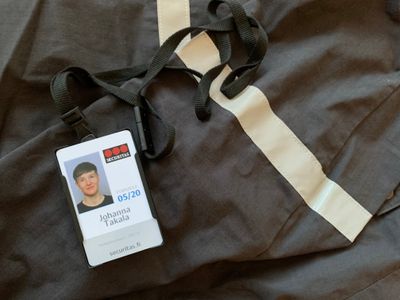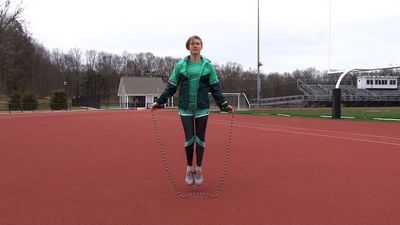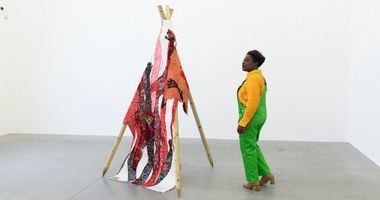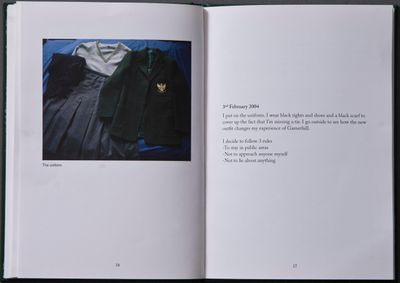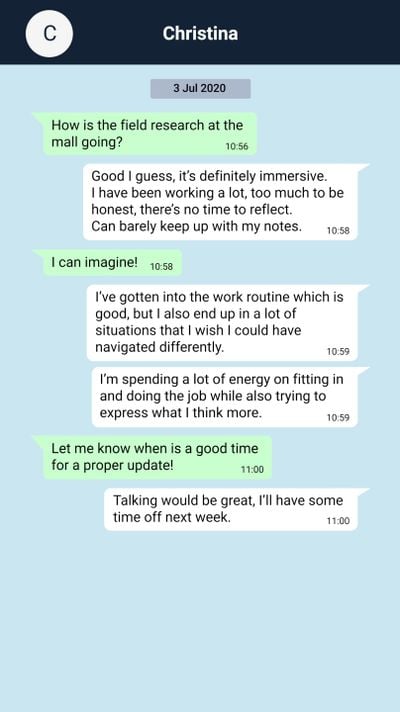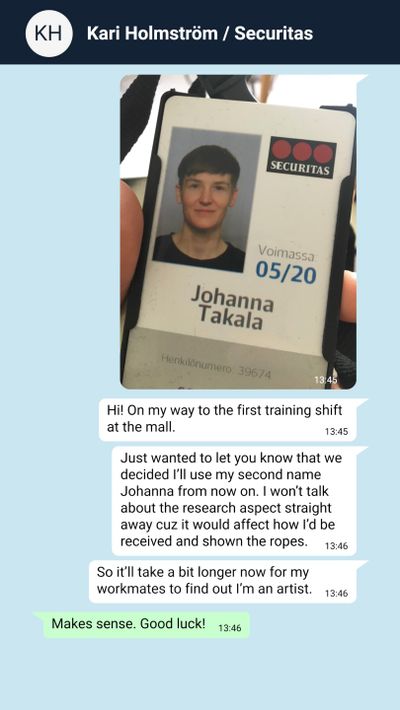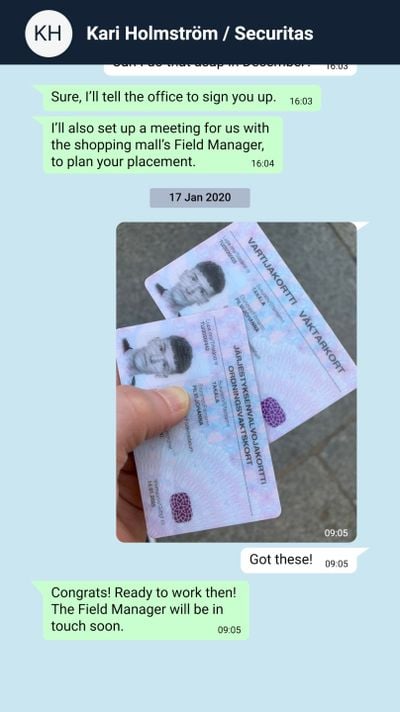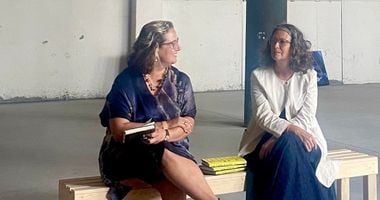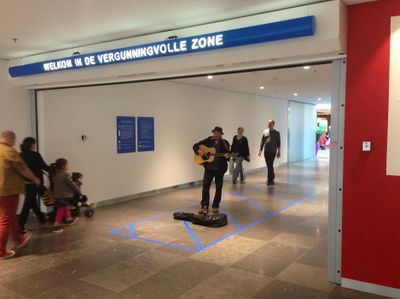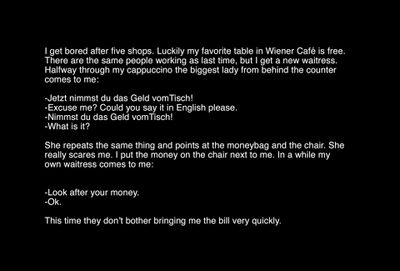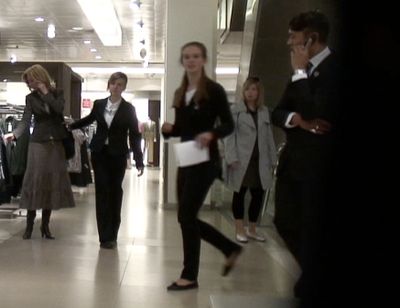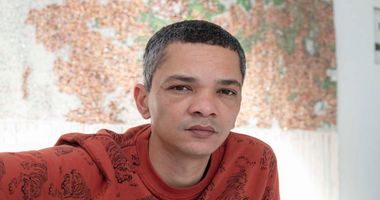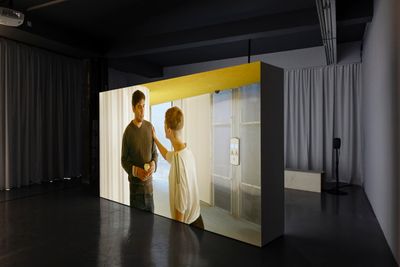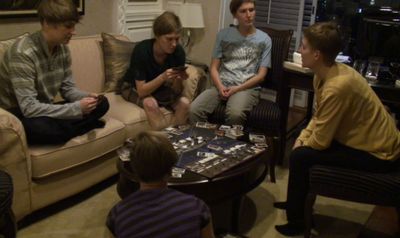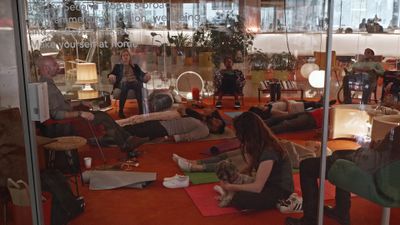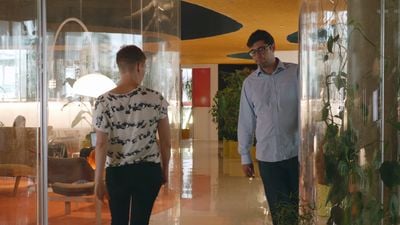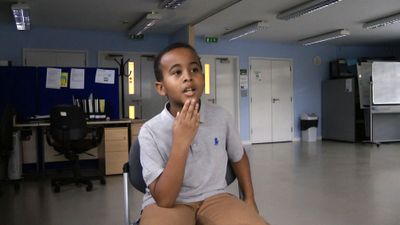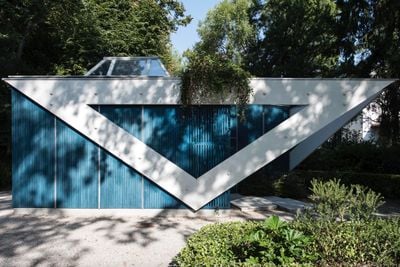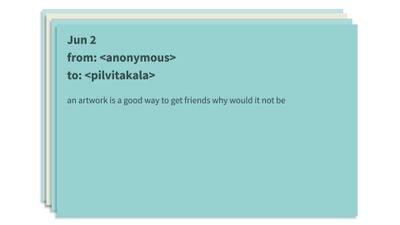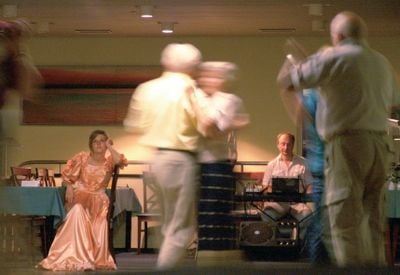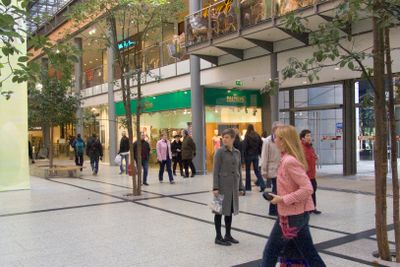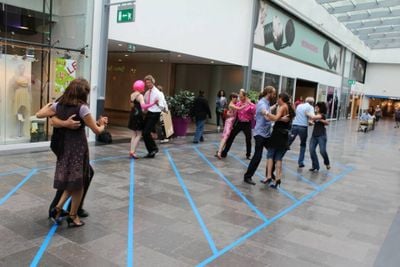Pilvi Takala: 'for Close Watch, discomfort acts as a guiding feeling'
IN PARTNERSHIP WITH the Finland Pavilion, 59th Venice Biennale
Pilvi Takala. Courtesy Ugo Carmeni and Frame Contemporary Art Finland.
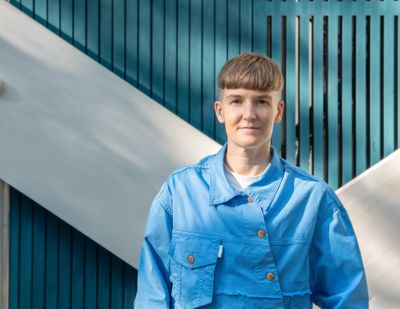
Pilvi Takala. Courtesy Ugo Carmeni and Frame Contemporary Art Finland.
At the Finnish Pavilion in Venice, Close Watch (2022), a multi-channel video commission by Pilvi Takala investigates questions of public security and implicit bias following the artist's undercover research as a mall guard for Securitas, one of the largest security firms in Helsinki, Finland.
The video work expands on workshops Takala held with fellow guards to address the problems the artist encountered during her six-month employment, both in the industry and within the notion of public security as it becomes a form of discipline and surveillance, given the power imbalances and social norms dictating tolerated behaviours in shared spaces.
Going undercover to infiltrate communities and disrupting social equilibrium is not foreign to the artist, whose previous projects contested similar boundaries between public and private, with Takala walking with a transparent bag of cash inside a Berlin shopping mall for Bag Lady (2006), becoming at once a security threat and subject of protection.
A slideshow installation documenting the week-long intervention reflected how private property falls under public scrutiny when carried into a shared space. Beyond object and money, these can be culture, leisure, and aspirations. This was explored in Takala's video work Real Snow White (2009), in which the artist, dressed as Snow White, confronts Disneyland's security about the regulation forbidding visitors to wear the princess costume on its premises.
The dreams we are sold often originate from the same places, the artist reflects. Prescribed ideas, ideals, and ways of being turned normative from repeated exposure in social settings, until the newcomer's arrival disrupts existing habits.
This phenomenon was explored in The Trainee (2008), which documented Takala's infiltration of the Helsinki consulting firm Deloitte to explore its work culture, while casting herself as the outsider with an inclination for non-action. The same boundaries were contested in Drive With Care (2013); this time, staged alongside teachers in an elite boarding school in the U.S.
In Takala's experiments, what becomes evident are the social structures that frame each ecosystem—be it the mall, the educational establishment, or sites of leisure, which generate a sense of order offering specific instructions as to how to behave—and the shared rules that dictate how we perceive, relate, and act towards others.
As Takala negotiates along the lines of tolerated conduct, what is brought to the foreground are those who stand at the margins of structures and systems, either by choice, or from the inability to conform to group expectations, be it in action or appearance.
The identities we take on, along with their implicit workloads, were explored in the 2018 exhibition Second Shift at the Kiasma Museum of Contemporary Art Helsinki (24 August 2018–17 February 2019), which looked at the emotional labour performed by women that have no monetary value in the capitalist system.
Between what we give and what we take, what is said and left unspoken, the two video works on view, The Stroker and Admirer (both 2018), explored interpersonal boundaries and nonverbal communication, showing the artist extending physical contact with strangers without their consent in the first, engaging an anonymous cyberstalker by email in the latter.
Housed at the Alvar Aalto Pavilion of Finland at the 59th Venice Biennale, Close Watch extends Takala's existing line of inquiry into invisible boundaries and the bodies found at its margins, and offers a timely address that prompts a re-thinking of privacy, power, and the ways we relate to others.
In the conversation with the Pavilion's curator Christina Li below, Takala reflects on the trajectory of her practice, her undercover work with Securitas, the importance of confronting implicit bias, and the making of Close Watch.
CLFor Close Watch, your new project for the Finnish Pavilion at the 59th Venice Biennale, audiences familiar with your practice will recognise your ongoing investigation into social codes and how they play out in communal and public settings.
How do you pick the contexts in which you work and the communities that interest you? Can you share the genesis of Close Watch? How did this interest in security, and in this case, private security come about?
PTEarly in my career, I tended to make work in settings I encountered in my everyday life or at least were commonly accessible, as with the works Bag Lady, The Angels (2008), and Real Snow White.
I gradually moved to closed situations that required a particular person to provide access, either through a formal invitation in The Trainee (2008), The Stroker, or through my own connections in Drive With Care (2014), Players (2010), and Close Watch.
It's often a feeling of unease or discomfort that provokes my interest in a certain site or community. If I already have some of the tools needed to navigate the situation, then that's the ideal combination: thinking that I could fit in while knowing I can't.
In my earlier works, I had been the subject of several security interventions, so I'd already been thinking about what this industry is like and how the individuals within it navigate their work. I also noticed how, especially in Finland, there seems to be more and more security in public spaces, which made me wonder how 'disturbing behaviour' is defined here.
All my works have been interested in control and how we police each other through social pressure.
Due to the potential risks involved with exhibiting my work Admirer, the Museum of Contemporary Art Kiasma in Helsinki assigned Kari Holmström, the security manager at Securitas, in preparation for my 2018 show, Second Shift. Together we discussed the risks at length, and I received specific conduct advice.
Over the years, Kari has worked in many positions in police and private security, gaining specialist knowledge and insight into behaviour. He also did undercover work, so it was clear we had some interests in common. When I was invited to make a proposal for the Finnish Pavilion, I already knew that I wanted to research private security from the inside, so I got back in touch with Kari.
CLI get a sense that, through your work, you are moving into power structures and apparatuses that underpin how our rights as individuals are defined and protected within society. With Admirer, you worked out a contract and explored the legal ramifications of this document with an anonymous person who sent you a torrent of unwanted and aggressive messages.
For Close Watch, you were interested in the legal consequences, as well as the accountability of individuals who use excessive force, and acceptable behaviour in guard work. What prompted this shift?
PTAll my works have been interested in control and how we police each other through social pressure, but you're right, in these new works there are larger, more institutional mechanisms at play and these two pieces are definitely connected.
Admirer came about because I was being stalked and harassed online by an anonymous person: an all-too-common situation; in my case, prompted by me showing work in public. While it includes structures that enable the stalking—like anonymity, lack of consequences, and misogyny—I also had access to institutional backing that protected me from the more dangerous outcomes of stalking.
This backing enabled me to negotiate with the stalker, which otherwise would have been too dangerous. Being protected by private security, I started considering what security actually means and what it would be like to work in this industry, which led to Close Watch.
CLIn your interventions and video works, it is not uncommon that you enter a situation where your body becomes the site of embodied knowledge, emotions, and experiences.
Would you say that your experience of working as a security guard for six months for field research has been different to your other kinds of field work or interventions such as The Stroker or Drive with Care? What kind of strategies have you adopted differently within this project?
PTIt was different. This new project was a lot more demanding, not just in terms of the amount of time I spent on the job, but the role itself, which required me to learn and perform many things to pass as a guard. The job requires a lot of consideration. You constantly have to make decisions that are far out of your comfort zone.
Whereas in Drive With Care I followed someone at their teaching job. While I was on campus, there wasn't too much individual responsibility falling on my shoulders, beyond my responsibility as an artist.
For The Stroker, I invented my own job; it was emotionally heavy labour, but I decided the parameters so I could take a break whenever I needed to decompress. My assistant Iona was in the space too, so there was someone else to observe, make notes, and then debrief with.
Because I knew the field research for Close Watch would be demanding, I had plans to work part-time to make it less intense, but after the first lockdown in Finland, I took all the shifts offered to me. I could not have anyone on-site with me, take a break when needed, or make notes in all situations.
I did make notes on my phone when I had a spare minute, but mostly I had to document via a scheduled call with Iona, who transcribed my recollection of each workday.
Each shift was so dense that much of our focus was spent on getting the information down, rather than being able to properly debrief and reflect. It was necessary to have someone else to 'witness' my time in the field, even in this remote way.
CLClose Watch is incredibly research-driven, perhaps more so than your previous works. Can you speak about the methodology you have developed that is particular to this work? How did it culminate in the workshop you filmed, and why did you choose Forum Theatre as a guiding method in organising the workshop?
PTThe methodology is always developed in the process. Here, it was clear that I needed quite some time to understand what working in the field is like and to experience it myself before trying to have any input as an artist.
I accumulated a vast amount of field notes and when reviewing them, I kept thinking: Why didn't I bring this up? Why didn't I ask this or push this point? What actually happened here? I then presented some of these unresolved issues in anonymous interviews with ex-colleagues.
Even though most of us would like to be the person to step up and put an end to problematic behaviour in the field, in this line of work it's extremely hard for many reasons.
Finally, we had the chance to speak without peer pressure or having to rush to the next task. The interviews lasted around three hours each, some even longer. I invited both the colleagues I had a good relationship with and ones I didn't feel comfortable with; some declined the invitation.
Despite different opinions and approaches, negotiating the need to support your colleagues while having the autonomy to intervene or stop excessive use of force was a shared concern. Even though most of us would like to be the person to step up and put an end to problematic behaviour in the field, in this line of work it's extremely hard for many reasons. More often than not, in the moment guards end up not intervening.
It became important to create a workshop for my colleagues and I to develop skills to shift away from unquestioning collegial support when the situation calls for it. I chose Forum Theatre as the method because it was a fitting way to explore how a guard can influence the 'aggressor' from the position of a 'bystander'.
It was crucial to act out the scenarios in the workshop, rather than just talk about them—to provide something concrete that the guards could take forward as a starting point.
Having almost no experience organising workshops or participatory theatre, I chose a technique that is widely used. Annukka Valo, who developed the workshop with me, had previously done Forum Theatre with prison guards. Because I had never practiced it myself, the workshop was quite experimental, and I didn't know if I would end up using the footage we shot.
CLThere is always a sense of vulnerability when you work on a project, but in this instance, you were also trying new techniques. You got an extra year to work on this project due to the pandemic. Does time factor within your practice? It does provide a specific frame and set of conditions, say compared to your relatively 'instantaneous' interventions in the past.
As someone who has followed the process so closely, it was interesting to see how the project progressed over three years. Since this is one of the longest projects you have worked on, how have the conditions of this Venice commission impacted how you approach your process in relation to its outcomes?
PTMy working processes are getting longer. Two to three years is the standard now—I don't know if I can do anything fast again. Close Watch was filmed over three days in one workshop, so in that sense, it's compact. Although, we did shoot additional material later.
But the way we worked up to that point and the editing and post-production work required a lot of time, so the extra year was very much needed. If I'd had less time, I would have been unable to try so many new things I never thought I'd do. It was personally more exciting for me this way.
Developing this commission for the Venice Biennale means there were resources to work more ambitiously. It also gave me the time to develop the work and a deadline to work towards, which was necessary, because I could see myself getting completely lost in the research.
The workshop was just a try-out, but it felt urgently needed. As with other works of mine, the intervention and urgency to experience them comes first, then I find the form the piece takes.
CLThe shopping mall, or shopping spaces, is a recurring setting within your pieces; you have dealt with it in Bag Lady, Vergunningvolle Zone (2013), and The Angels. What draws your attention to these quasi-public spaces? How does the mall operate within the context of this new commission?
PTIn Berlin, I never go to malls, but in Finland it's unavoidable. Malls make up a lot of the public space there and contain transport, municipality services, and infrastructure people need. The space itself is privately owned, but it is still defined by law as a 'public space'. I am interested in finding out to what extent space is really public. In what ways is it controlled and for whom?
In Close Watch, the mall is an area that is completely surveilled and controlled by guards, which makes it 'safe' in some sense. If you have a medical emergency, help will arrive swiftly. If there is a fire or a similar kind of exceptional situation, there is a clear protocol to protect the public.
However, if you behave in a way deemed strange or inappropriate, guards will follow you on surveillance cameras and speculate about what you are up to. In the context of the mall, even sitting on the stairs and hanging out with your friends is cause enough to be moved along.
So we have this kind of public space that could be called 'well organised', but is it actually organised in a way the public would want? It's a public space governed by private interests, which makes it somewhat complicated.
CLSince we are speaking about the mall as a site, the project on view in Venice is a multi-channel video installation. Can you talk about how you approach space in your video installations?
PTIt's really the very last thing I think about in my process, which is why it's good to work with a curator, or even better, an exhibition architect. Since you were quite instrumental in shaping how the exhibition looked, maybe you can talk about what we did with the space?
CLThe Aalto Pavilion is a unique space that comes with its specific challenges; it was evident to us from the start that we needed to create a setting that works with the architecture to frame the work. We worked with exhibition architects Studio LA to create a site-specific installation that accentuates the spatial dynamics and surveillance work implicit to guard work in the public sphere.
The original space is quite straightforward, but by adding a one-way mirror, the space is separated into two environments that frame the videos and immediately trigger an awareness of your relation to others in the space, and who's watching whom. This separation means that audiences will need to enter both spaces from the external walkway on the left-hand side of the building, so in a way, this installation considers not only the interior but the entire grounds of the Finnish Pavilion.
This work, like many of yours, prompts us to reflect on our own role in affecting each other's actions. You had quite a number of brushes with security staff in your previous works. What were your initial thoughts about guard work and were there surprising things you have discovered, now that you have gotten into this line of work?
What I found important in this work is that you are trying to uncover the humane aspect of those who make up the often-invisible workforce, such as guards, cleaners, or receptionists who do the maintenance work we take for granted. On top of that, in the discussions you have with your ex-colleagues in your interviews and the workshop, I recognise your intent to instil a sense of agency in what may be seen as menial yet important work guard staff do daily.
PTOf course, I held stereotypical expectations about how guards are: authoritarian, conservative, racist, and macho, but our encounters have not been too hostile. It has to do with me being a white woman, in a Snow White costume or with a lot of cash in a transparent bag, and to the guards, more of an annoyance or someone to protect than a predator.
As with other works of mine, the intervention and urgency to experience them comes first, then I find the form the piece takes.
I've also been very aware of provoking a security response and of my rights. The experience for people of colour and other visible minorities is often very different; they can be seen as a threat because of racist stereotypes and there are many severe incidents of race-informed violence.
It's often unclear to the public what rights guards have and on what grounds they can interfere with your behaviour. While situations that require force don't happen every day, public encounters that can lead to use of force happen all the time.
Guard work is a lot about maintaining property and the systems that keep it functional, looking for lost cars in the parking lot, and opening doors. It's also about contact with regular customers, who might repeatedly violate mall rules or commit crimes and be taken to the holding cell.
What interested me was how this everyday work is done. When is it 'care' to take someone into a holding cell because they appear too drunk to get home by themselves, and when is it patronising? How do guards approach the person scootering inside or drinking? What is the interaction like with the person detained for shoplifting?
People might, and for good reason, distrust guards and feel very uncomfortable when approached by them. What is the best way to navigate these situations without escalating them? How do guards react to all the different emotions and behaviours triggered by their presence?
While working within a framework of rules and regulations, guards have agency in how they do their work. They can influence the norms in their workplace and the kind of conduct that is encouraged and tolerated.
CLHow do you relate to the word 'discomfort'? In Real Snow White, Bag Lady, and Trainee, for example, I feel like once you cross over into that territory, you persist and something new emerges. How do you navigate that emotive space and employ it within your practice?
PTI'm really in close contact with the word 'discomfort'—in some projects maybe 'awkwardness' fits better, but for Close Watch, discomfort acts as a guiding feeling for what might be interesting or productive and provides the direction to move in.
Using my own ability to sit with or endure certain types of discomfort is what I do in my practice, so it's really a tool. It's also something I'll continue to develop. In The Trainee, I challenged myself to endure the social pressure to do anything other than sit and think. It was hard work, but the activity was quite simple, I just shut down every impulse to do something.
With The Stroker the gesture was already much more complex; I had to actively approach people and breach the social boundary that made my touching outside of the norm while taking in their emotional responses and respecting the clear rejections.
I didn't want to ignore the social cues and touch everyone, I wanted to learn what they are and still go against them just enough. This was something I could balance after a decade of practice. While working on Close Watch, I wondered whether I chose a context that was too uncomfortable, because I didn't have the kind of control over my own behaviour that I've had in previous projects.
In many instances, I did act according to social pressure rather than my own values. Then again, this was very interesting to me, because that's how guard work is; the days are long and you are not well prepared for what you'll face.
What made it possible for me to be at that workplace and do the job? How did I make up for my lack of experience and confidence in what I was doing? How much did I want to be respected by my colleagues and why? I found myself performing authority in a way that I didn't want to, just because in the moment I defaulted to something learned, or something I didn't even know I'd learned.
When I tell my colleagues why I am interested in security work at the mall, I am telling the truth. I was genuinely interested in the work and how to do it well.
It surprised me to find myself saying things I thought my colleagues wanted to hear, and how quickly things become normalised, even when you are uncomfortable. I didn't manage to do the job up to my own ethical standard, which again, I think is a feeling shared by many guards. If I were to do more of this work, I'd need to prepare better. That also says something.
CLThe topic of ethics comes up alongside discussion of your work, particularly with your covertly filmed pieces. Since you are often implicated or assumed to be complicit through whichever way you gain access to communities or situations, you are hyper-aware about the people and structures that also become part of the work.
When you are working in the mall, your ethics and what is considered protocol or acceptable behaviour at the workplace can be miles apart. Can you speak about how you approach this terrain in your work? How did you negotiate this within your new piece?
PTWhen working undercover, the main issue is that my intentions are hidden. I never do anything undercover that I can't stand behind ethically. My backstory is the same—I say I had worked in an art museum as a guard, which is a common job for artists.
When I tell my colleagues why I am interested in security work at the mall, I am telling the truth. I was genuinely interested in the work and how to do it well. I had anticipated that my colleagues would find out about my art career even sooner, but thought it was worth using my second name 'Johanna' and get introduced to the workplace as any new guard would.
Being undercover for so long with the same colleagues was very different than posing as the 'touch worker' in The Stoker, for which I imagine people would be mostly relieved to hear I wasn't 'real'. Because I had extended contact with my workmates as a 'normal' colleague, I wanted to come out to them as an artist before I finished working.
On the other hand, my guard colleagues understand the reasons for staying undercover probably better than any other professionals, as withholding information is part of the work. Perhaps the biggest ethical question for me was whether I could work ethically, which was also the main question in my research.
As the work is presented to bigger audiences, there will be a greater variety of feedback, which I am looking forward to.
It was more complicated to relate to the workplace culture in a way that felt right, responding to racist jokes or 'war stories', and laughing at someone getting hurt. Or when, in the chain of command, I am asked to do something I'm not sure I want to do, how much space I have to question higher-ranking colleagues.
I've worked with hidden cameras a lot and have been consciously working away from that method as it doesn't work for many things—even if I would ask for consent after filming, as I did with The Trainee, the material is still shot without consent.
In Close Watch I wanted the workshop to be a space for discussion and trying things out, without pressure to say or do the right thing. I also wanted to film and document it for myself, and possibly use it in my piece, so I agreed with participating workmates that I wouldn't use the material without their consent.
Of course, the presence of a camera changes the dynamics because people perform for the camera, but guards are also used to being filmed at work. The most dramatic situations are saved on tapes in the control room and watched over and over by colleagues.
The next ethical question has to do with editing the material—how the people are presented and what story the work ends up telling. I showed a rough cut of the material and the final edit to each participant to ask if they'd be ok with me using it and make sure they don't feel misrepresented.
CLIn this project, you have been quite careful to maintain your autonomy as an artist, and to keep a professional relationship with Securitas, who agreed to help you in your work. The trust you have built with your ex-colleagues has also been crucial in the making of the work, which by being undercover can easily unsettle as well.
Can you speak more about the set-up, the importance of power dynamics with the stakeholders of this work, and within the work community you went into? Aside from the discussions captured in the publication and the film with your former co-workers, there were many moments of constructive discussion with Jarmo, the CEO, and Kari in the final work you made.
PTThis is the first project I've done with a company for which the project is in no way initiated or financed by them, which was quite important in this case. Representing Finland in Venice and having my own financing for the project was a good position to negotiate from.
Our relationship was clear from the start: I am not making anything for Securitas, but they might of course benefit from letting me in in the form of knowledge production, organisational development, and publicity, even if that would be a gamble.
I wanted to give my research time and space, so after Securitas' CEO agreed to the project without knowing what would come out of it, my relationship with Securitas was one of employee-employer.
Of course, the field managers were aware of my special position, and I could ask them for advice, but I was just working like everyone else. I told Securitas about my plans for the interviews and the workshop, and they assisted to provide the access I needed, but there was no other oversight. It was understood that I would work on my own thing.
After my participating colleagues had consented to me using the material and I had a clear direction for the artwork, I showed my rough cut to the Securitas management. This was really the first moment I would share my findings and analysis of the workplace with them and talk about the things I found problematic beyond what is in the film.
This conversation about improving the organisation and responding to the problems continued after I showed my final edit of the film to the participants and Securitas staff in March and will continue after the work goes public in Venice and returns to Finland in early 2023.
CLAside from the multi-channel video installation, there is a book as well as a website. As I was following the extensive research process from the sidelines, it felt necessary to find a form where the different facets of the work reside and respond to each medium.
We both thought it was important to have the project circulate in different ways. On the website, you see live webcam streams from all over the world; not only are they portals and surveillance apparatuses, but familiar imagery that we associate with security and the work guards do.
How does the publication and the website relate to what audiences will see in the exhibition in Venice?
PTThe publication is primarily about the process that led to the film and a space to share some of that extensive research. It was quite clear to both of us that the publication would have to be more like an artist book, rather than a collection of commissioned texts.
The publication works both on its own and as a companion to the video installation. There was so much text and research material already generated within the project that would not be in the film, together with documents, images, and your curatorial text. The website is the most accessible component and something that is flexible to expand upon in the future.
There are many conversations to be had around the subjects the work raises, which in many ways are only started as the work goes public. I wanted to have the chance to add content later to follow up on these conversations.
CLEven though the work deals with difficult subjects, in the making of the workshop, the film, and the book, you made sure to handle them in an adequate and careful manner. It is notable that this work is centred around the conversations that were had around, rather than directly about, urgent yet hard to confront topics such as racist humour, microaggressions at the workplace, and other problematic conduct.
There are so many subtleties that emerge between the lines when you follow the flow of discussions. Was it a deliberate choice to handle and present these issues through workshops and dialogues and not other means?
PTI guess it comes from my experience of being unable to get into a constructive dialogue in the workplace. When I did question things, my workmates often didn't understand why, or got defensive, or just didn't care about what I had to say.
Close Watch can be understood as a critique of the structural issues, as well as inadequate attention towards problems of racism, toxic behaviour, and excessive use of force in the private security industry.
So I was constantly thinking about how to communicate with them, especially if I didn't want to adopt the way of speaking about things that is already used in the workplace, like turning what I was concerned about into a joke. So the workshop was an attempt to bring about a missing dialogue and communicate more clearly and specifically with my colleagues by staging scenes about what I personally found problematic and what I knew they found problematic or difficult too.
Dialogue is a challenge. I do believe that some conversations happened in the workshop that could not have taken place elsewhere, but even within this controlled space, it was still frustrating at times. There were moments when it felt like it wasn't going anywhere.
CLAn underlying thread in Close Watch is trying to understand viewpoints that may be unfamiliar and make space to question dominant social values and assumptions. You have brought the expertise and perspectives of many people to the project to address these potential blind spots and ensure that they are sensitively addressed. Can you elaborate on that?
PTApart from my own research, I consulted different people: a former C.I.A. agent, an anti-racism trainer who has trained police, an ethnic-profiling researcher in Finland, and someone with experience facilitating participatory theatre with many different groups.
I brought in Annukka to develop the workshop with me, and hired a Finland-based anti-racism consultant with experience using Forum Theatre as a workshop tool. Later, as we got closer to finishing the video edit, we had beta viewers of different backgrounds, ages, and nationalities to watch and comment.
As a white Finnish woman who was already familiar with the security field and had been working with this material for a long time, it was necessary to show in-progress edits to people with varying experiences and backgrounds, to discuss how the work comes across and whether there were things I'd missed or become immune to.
Beta viewing is something I would definitely budget for and schedule in next time I'm making something. It's a really great way to improve and reflect. Of course, this is just a small group of people. As the work is presented to bigger audiences, there will be a greater variety of feedback, which I am looking forward to.
CLClose Watch can be understood as a critique of the structural issues, as well as inadequate attention towards problems of racism, toxic behaviour, and excessive use of force in the private security industry. These workplace problems are a mirror of those we encounter in society.
Like you said about the work being shown to larger audiences, I am intrigued by the conversations that will extend from the work. These are issues that we as a society need to and are trying to find ways to recognise and discuss, as a means of addressing prejudices and biases that lead to the unjust treatment of individuals based on race, class, and gender.
While the workshops you developed attempt to engage with the problems you encountered during your employment in the mall, they were by no means conceived to change the industry. How do you see this work vis-à-vis the industry and what do you hope audiences and the private security industry take away from it?
PTChange is needed and I want to contribute, but I don't imagine I can change the whole industry with one workshop and film. I start by looking at what is there: what the guards actually think, what choices they have to make, under what conditions, and how they rationalise things.
Each guard has agency, but to change the industry a lot must happen. To start, I believe there should be a legal requirement for more training for guards, including anti-racism training for everyone so private security companies can offer it without market disadvantage, and changes within organisational structures and oversight—just to name a few things.
I am not the expert, but I do expect Securitas to develop their organisation and have recommended that they get help from professionals who do diversity and anti-racism work.
In the best-case scenario, Securitas becomes the most diverse anti-discriminatory workplace and security provider and other companies follow suit. Public discourse around the film also puts pressure for change, so that's another way this one workshop that became a film has an effect.
As you say, problems like racism are everywhere in society and everyone has biases, but as guard work is very much about profiling and predicting behaviour, it also re-enforces biases. So it becomes even more important to be aware and work against unconscious bias, especially because guards can legally infringe on basic rights. There is a lot of work to do. —[O]
The Pavilion of Finland at the Biennale Arte 2022 is commissioned by Frame Contemporary Art Finland, 23 April-27 November 2022, framefinland.fi.



